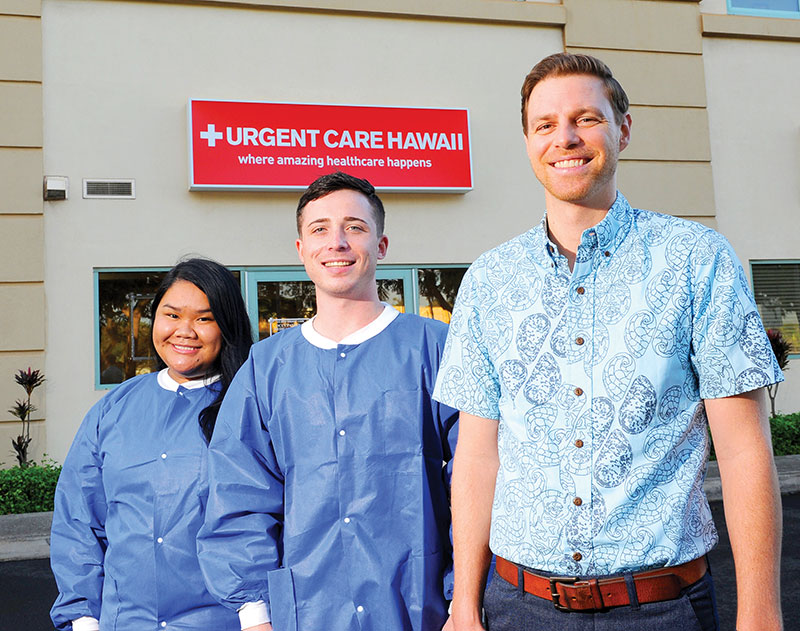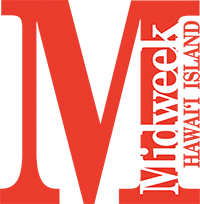A Picture of Health

(From right) Ryan Ashlock, president of Adventist Health Castle, leads a group of talented health care professionals at the medical center. They include Brandon Tobias, medical assistant, and Stephanie Tenoso, lead patient access representative.
The state of Adventist Health Castle has never been better, thanks in part to its recent acquisition of Urgent Care Hawai‘i, which allows the full-service medical center to expand its reach to neighboring communities.
In sickness and in health, Adventist Health Castle (formerly known as Castle Medical Center) has stood by the Windward O‘ahu community for nearly six decades. Now, the faith-based, nonprofit integrated health system is extending its care to other areas of the island with the acquisition of Urgent Care Hawai‘i.
“This is something we’re really excited about,” shares Ryan Ashlock, president of Adventist Health Castle. “(One reason is) Castle does not have urgent care services, so by acquiring Urgent Care Hawai‘i, we now can complete the continuum of care by providing urgent care services. Secondly, we had a goal of expanding our services both here on the Windward side and even beyond … We are just really excited to be able to take the outstanding people and the care that we provide here at Castle to new communities for us.
“Another reason why we’re excited about having the Urgent Care Hawai‘i team join Castle is it’s an extremely innovative group. They’ve done an outstanding job navigating through this pandemic and really keeping themselves relevant. We are glad to have them here to bring their innovative spirit into our broader organization and really look at how we can improve and expand the urgent care services that they’ve historically provided.”
Currently, there are three active Urgent Care Hawai‘i locations: Kailua (660 Kailua Road), Pearl City (1245 Kuala St.) and Kapolei (890 Kamokila Blvd.).A fourth location in Waikīkī/Ala Moana (1860 Ala Moana Blvd.) is temporarily closed primarily because of the reduction in tourism. The state-of-the-art facilities are open to anyone (you do not need to be a Castle patient), walk-ins are welcome and almost all insurance types are accepted. Services offered include immediate infant, pediatric, adult and geriatric care; basic laboratory, X-ray and telehealth services; occupational medicine and COVID-19 testing. With the added urgent care centers, patients now have more options and typically quicker access to care than at an emergency room.
“We want to make sure our ED (emergency department) is kept available for those that are experiencing a more traumatic injury,” notes Ashlock, “and keep some of the things like colds, flu, sore throat, minor scrapes and cuts, that are more appropriate to be in an urgent care environment, and frankly it’s more cost effective for a community member to be in an urgent care than it is to be in a hospital environment. As you might expect, a hospital is a little bit more expensive because of the variety of care that we have to be ready to provide, that’s not as true in an urgent care setting.
“As we move into this world of population health and health care, we’re all really focused on how do we reduce the total cost of care? We want to make sure patients are being cared for in the right setting and previously we didn’t have urgent care services, so we weren’t able to refer patients but now we do. It’s mutually beneficial because it’s more cost effective for us.”
Castle’s Rich History
Adventist Health Castle, a full-service medical center offering a wide range of inpatient, outpatient and home-based services, opened on Jan. 16, 1963, as Castle Memorial Hospital with 72 beds and 14 bassinets. However, the groundwork began much earlier when a small community group came together and launched a campaign in 1953 to establish a medical center in Windward O‘ahu. According to Ashlock, there was no health care on the Windward side in the 1950s, only part-time ambulance service from 1 to 9 p.m. Friday through Tuesday.
“It was a smaller community certainly at that time but driving over the old Pali Highway as I understand it was quite the drive and not an easy one,” he says. “Whenever there was a medical issue that came up, there were many times where physicians that lived on this side of the island had to throw them into their car and take them over to Queen’s or St. Francis. Because of that, the community that was growing really wanted to ensure there was access to health care easily and quickly.
“(During that time) there were two events that happened — one was the roof caved in on five workmen at the Cornet building in Kailua and they had to then be taken via Dr. Robert Chung’s car … then just a month later, there was a 2-year-old girl that choked on a pill, and if there had been a hospital here, she may have survived. So, at that point really, enough was enough, and in December 1959, the state Board of Health approved the rezoning, and federal funds necessary to build the hospital were freed up.”
Ashlock lists Chung and Carolyn Rankin as the medical center’s major proponents, and notes the support received from Harold K.L. Castle, who donated the 10 acres of land that Adventist Health Castle sits on today; the Seventh-day Adventist Church, which offered $600,000 toward construction; and community contributions of $170,000. In 1983, the hospital changed its name to Castle Medical Center, and today, Adventist Health Castle is a 160-bed facility with more than 1,000 employees.
“What I always tell our leadership team and our associates is that we need to recognize the hard work that our community did to get this hospital here and, as a result, we have a responsibility and a commitment to deliver back really high-quality, safe patient care to our community,” says Ashlock.
Award-winning Care
This past spring, Adventist Health Castle received an ‘A’ Leapfrog Hospital Safety Grade, and for the ninth consecutive year, was recognized by Healthgrades for being in the top 10% nationally for patient experience. There’s also its birth center, which, for two years in a row, was listed on Newsweek’s Best Maternity Hospitals. And in 2017, the organization was recognized with the Malcolm Baldrige National Quality Award.
“At the time, we were one of only 32 U.S. hospitals to get (the Malcolm Baldrige), and still are the only organization in Hawai‘i to receive this award,” says Ashlock. “We’re really just proud of the achievements we’ve been able to get.
“One of the things that really makes our organization unique, I believe, is our people … from the moment you’re greeted until the moment you leave, I think you really notice that our people set us apart. We’re focused on whole person health and committed to having the most highly trained, empathetic staff shining through at every level of our organization.”
One Paradise To Another
Prior to joining Castle, Ashlock was the finance officer at Adventist Health Feather River and the executive in charge during the Camp Fire evacuation, restoration and recovery efforts in 2018. He moved to Hawai‘i three years ago and was chief operating officer before being named president of Adventist Health Castle in April.
“The entire town of Paradise was pretty much destroyed in that fire including a good amount of our hospital there … I was looking for new opportunities and it just so happened that there was an opportunity out here in Hawai‘i and somehow my wife (Elle) was open to the idea,” remembers Ashlock, who was born and raised in Glendale, California. “Here we are a few years later (along with their 3-year-old daughter Emmy) and couldn’t be happier. We’ve really enjoyed living in Hawai‘i. “The joke I kind of always make is, being at other hospitals within our system, I’d always see Castle being at the top in terms of metrics and outcomes, and somehow we could never beat Castle. So, if you can’t beat them, you might as well join them and that’s what I decided to do.”
As for highlights to look forward to in the future at Adventist Health Castle, Ashlock says they plan to expand its operating room capability, adding two operating rooms and a procedure room next summer on top of its existing four operating rooms. They also are in the early stages of starting a cardiac electrophysiology service, which is currently not provided on the Windward side.
“Also, the biggest one that’s going on right now is something called Hawai‘i Health Network,” adds Ashlock. “It’s a clinically integrated network and the purpose is to bring together health care providers into a partnership that’s focused on driving down the total cost of care and increasing quality … We’re just thrilled to be able to partner with some of these other independent physician organizations across the state to help them better serve their patients and together really improve the quality of the community that we serve.”

